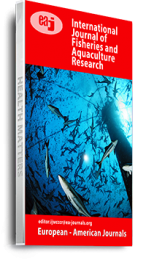Monthly random samples of the Por’s goatfish Upeneus pori (Ben Tuvia and Golani, 1989) totaling 274 fish were collected from the artisanal catch of Ain El-Ghazala lagoon, eastern Libya Mediterranean coast, during September 2015 to August 2016 for use in the present study. No collection was made during May, June and July because the study fish disappeared from the catch during these months. Total length of studied fish ranged from 8.5 to 20.4 cm. Degree of fullness of stomach classified as empty, trace, quarter, half full, three quarters and completely full was assessed visually for each fish. Diet composition of individual fish was established by points of assessment of gut content. Crustacea, represented by small prawns and amphipods, made up 50.3% by volume of annual composition of the bulk of U. pori diet followed by polychaetes (15.7%), mollusks represented by bivalves and gastropods (10.2%) and sea grasses (4.5%). Sediments made up 19.3%. These items were consumed all-round the year. Monthly changes in their ratios do not follow regular trends. In autumn crustaceans composed 50.7% U. pori food, sediments (19.4%) and polychaetes (15.3%), whereas in winter crustaceans composed (49.4%), sediments (22.0%) and polychaetes (14.9%). In spring crustaceans were ingested by (54.6%), sediments by (19.9%) and polychaetes by (14.9%). In summer the fish consumed crustaceans by (43.1%), mollusks by (23.5%) and polychaetes by (21.1%). Crustaceans, polychaetes, mollusks, sea grasses and sediments were consumed by all length groups of U. pori. However importance of crustaceans, mollusks and sea grasses increased as the fish length increased while that of polychaetes and sediments decreased. Crustaceans increased from 22.1% in the length group (8.5 – 10.4 cm) to 45.9% in the length group (18.5 – 20.4cm). Polychaetes decreased from 38.3% in the length group (8.5 – 10.4 cm) to 2.8% in the length group (18.5 – 20.4cm), mollusks increased from 11.3% in the length group (8.5 – 10.4 cm) to 31.5% in the length group (18.5 – 20.4cm). Sea grass ingested in the length group (8.5 – 10.4 cm) by 11.2% was increased in the following length groups and recorded the highest value (19.1%) in the length group (18.5 – 20.4cm). Sediments were taken up by 17.1% in small fish (8.5 – 10.4cm), then decreased with further increase in fish length.Fish with stomach half full, almost full and full of food together constituted 59.6% of all samples investigated during the study, whereas those with stomach that were empty, with traces of food and quarter full represented 40.4% of the total. The feeding activity was quite high during autumn (66.2%), spring (62.1%) and summer (70.1%) and low in winter (48.3%).
Keywords: Lessepsian, Mullidea, Por’s goatfish, Upeneus pori, food and feeding habits

